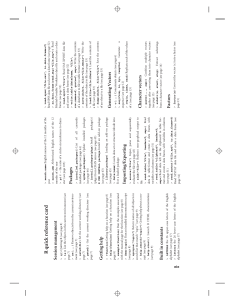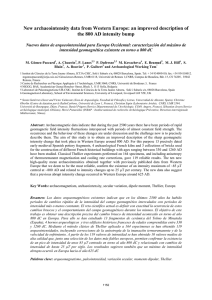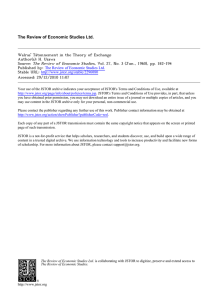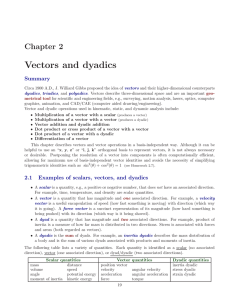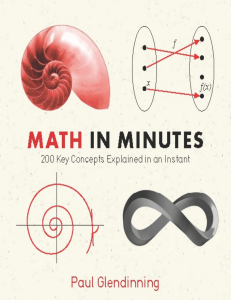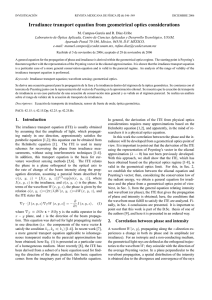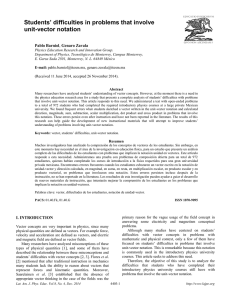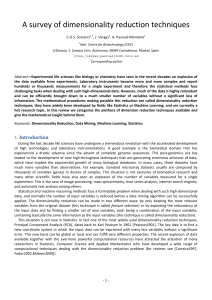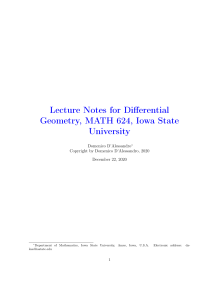Mathematical Modelling of Human Motivation: A Vector Hypothesis
Anuncio
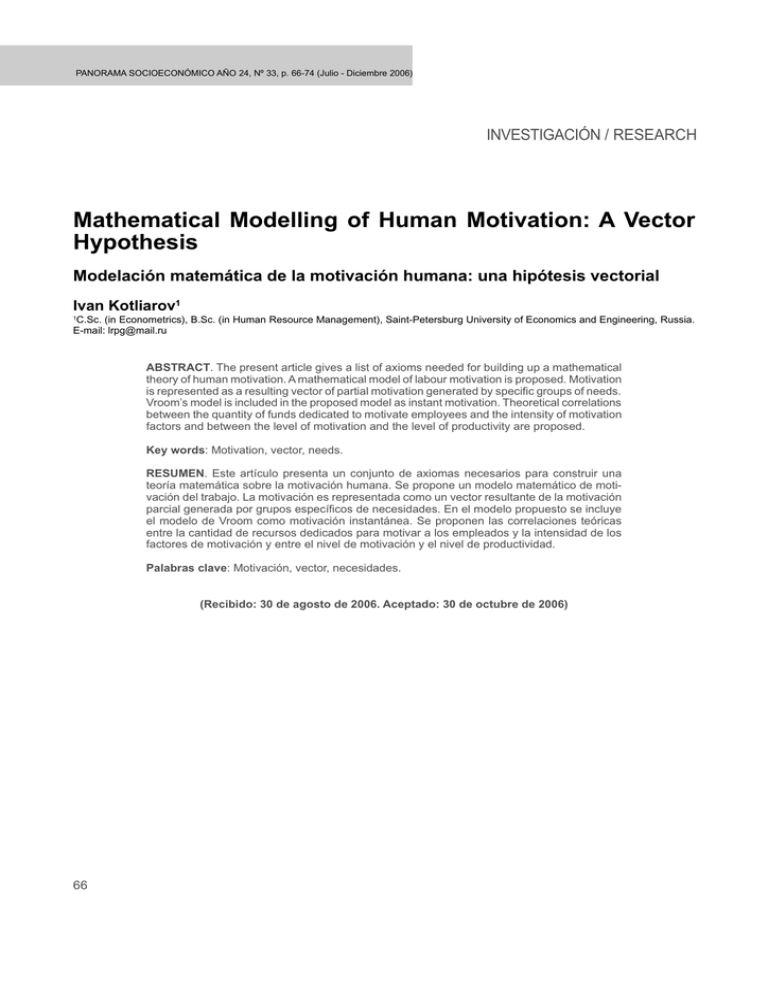
PANORAMA SOCIOECONÓMICO AÑO 24, Nº 33, p. 66-74 (Julio - Diciembre 2006) INVESTIGACIÓN / RESEARCH Mathematical Modelling of Human Motivation: A Vector Hypothesis Modelación matemática de la motivación humana: una hipótesis vectorial Ivan Kotliarov1 1 C.Sc. (in Econometrics), B.Sc. (in Human Resource Management), Saint-Petersburg University of Economics and Engineering, Russia. E-mail: [email protected] ABSTRACT. The present article gives a list of axioms needed for building up a mathematical theory of human motivation. A mathematical model of labour motivation is proposed. Motivation is represented as a resulting vector of partial motivation generated by specific groups of needs. Vroom’s model is included in the proposed model as instant motivation. Theoretical correlations between the quantity of funds dedicated to motivate employees and the intensity of motivation factors and between the level of motivation and the level of productivity are proposed. Key words: Motivation, vector, needs. RESUMEN. Este artículo presenta un conjunto de axiomas necesarios para construir una teoría matemática sobre la motivación humana. Se propone un modelo matemático de motivación del trabajo. La motivación es representada como un vector resultante de la motivación parcial generada por grupos específicos de necesidades. En el modelo propuesto se incluye el modelo de Vroom como motivación instantánea. Se proponen las correlaciones teóricas entre la cantidad de recursos dedicados para motivar a los empleados y la intensidad de los factores de motivación y entre el nivel de motivación y el nivel de productividad. Palabras clave: Motivación, vector, necesidades. (Recibido: 30 de agosto de 2006. Aceptado: 30 de octubre de 2006) 66 Mathematical Modeling of Human Motivation: A Vector hypothesis Ivan Kotliarov INTRODUCTION Effective control of an economical phenomenon requires a mathematical model able to provide a reliable qualitative description of this phenomenon and to ensure quantitative forecasts of its characteristics. Our understanding of the nature of human motivation did gradually improve over the years (we have now many more or less consistent theories giving adequate descriptions of motivation processes), but a good mathematical model of work motivation is not available. Actually the only example of mathematical approach towards this problem is Victor Vroom’s model [Vroom 1995], but it is rather qualitative than mathematical in the proper meaning of this word, as it limits itself to only one formula: M = RBW where M – motivation; R – employee’s expectations that his/her efforts will lead to necessary results; B – expectations that the results will lead to the expected remuneration; W– expected value of the remuneration. All other theories existing in this field: Maslow’s hierarchy of needs [Maslow 1970], Herzberg’s twofactors theory [Herzberg, Mausner, Snyderman 1959], McClelland model [McClelland 1961] – do not offer any quantitative methods for modeling motivation, they explore the psychological aspect of motivation but do not use mathematics at all. It is obvious that absence of mathematical tools in this field of human resources management is absolutely unacceptable nowadays and I will try to fill in this gap in the present paper. DEFINITIONS AND AXIOMS First of all, it is necessary to give a clear and precise definition of motivation. Motivation of a human being is a temporal and dynamic psychological state that determines his/her involvement in an action [Motivation 7; Motivation 8]. Motivation is sometimes referred to as process [Motivation 8] thus leading to confusion between 2 aspects of this concept: motivation as the psychological state of a person who is doing something and motivation as a process of encouraging a person to do something (the latter is better referred to as motivating). Motivation will be considered in this article as a state. A thorough analysis of motivation theories shows that all of them contain – either explicitly or, more often, implicitly – a set of basic rules (hereinafter referred to as axioms; some of these axioms have been formulated earlier, some should be reformulated from implicit indications, some are given here for the first time – I will indicate it below for each axiom). It is logical to use these axioms as a basis for a mathematical theory of work motivation (I omit the detailed overview of motivation theories in order to spare time; a good description from the management’s point of view can be found in [Mescon, Albert, Khedouri 1992]; psychological overview is given in [Il’jin 2000]). These axioms are the following (it is worth mentioning that the complete set of axioms is given for the first time; none of existing theories of human motivation operates with this list, they just use – explicitly or implicitly – some of them): 1. Human beings have needs that they want to satisfy. It’s a common place in most psychological and marketing theories. 2. Human motivation (understood as a person’s state that defines degree and orientation of activity of a person in a given situation) is determined by human needs. All content theories of human motivation include this stipulation as a basic hypothesis, while process theories include it implicitly (see above, for example, for Vroom’s model: motivation depends on the value of the remuneration, but value of a good is a function of its utility, that is, of its capacity to satisfy human needs). It is easy to conclude for the axioms 1 and 2 that the satisfied needs have no influence on human motivation. It is very important to remember that needs that are not actually satisfied, but whose satisfaction is perceived by a person as guaranteed (in other words, needs whose satisfaction is seen by a person as guaranteed to a such degree that he or she perceives them as satisfied, despite the fact that they actually are not) do not have influence on human motivation either. For example, in economically developed countries (like EU), needs belonging to lower levels of Maslow’s pyramid generally have no influence on human motivation [Mescon, Albert, Khedouri 1992] because of people’s confidence in their present and future situation thanks to relatively high salaries, good social security systems and powerful trade unions. However, any of these low-level needs in any moment may be actually unsatisfied. 3. Human needs can be divided into separate more or less homogenous groups, each one of these 67 PANORAMA SOCIOECONÓMICO AÑO 24, Nº 33, p. 66-74 (Julio - Diciembre 2006) groups contributing to the general motivation (generating a partial motivation). I will refer to these groups of needs as to motivation factors. An indication to this axiom first appeared in content theories with their divisions of needs; however, to the best of my knowledge, neither this axiom, nor the concept of partial motivation have not been proposed before. 4. In general, the number of groups of needs influencing a person’s behaviour in the moment t is superior to 0. Mathematically it can be expressed as follows: if N is the number of separate groups of needs, N>0, and if n is the number of groups of needs determining an individual’s behaviour in the moment t, then. 0<n<N This axiom has not been formulated explicitly before, however some hints can be found in the literature. The axiom 4 leads us to the conclusion that the general (total) motivation is equal to 0 in only one case: when all partial motivations are equal to 0, or, in other words, if one or several (k, k<n) partial motivations are equal to 0, the total motivation will nevertheless be different from 0. Mathematical corollary to this conclusion is that we cannot calculate total motivation multiplying partial motivations. 5. Every group of needs can be described by two characteristics – intensity and importance. Intensity is the quantity of goods required to satisfy this need. Importance is the priority of a certain group of needs over other groups. These characteristics can be expressed in quantitative from, and. Therefore, it is possible to build up a quantitative theory of motivation. The concept of importance dates back to Maslow’s hierarchy of needs and it is clear that the concept of need includes the concept of intensity; however, this statement has not been made explicitly before. 6. The general motivation directly depends on groups of needs (motivation factors) – that is, if the intensity and/or the importance of a given group of needs is growing, the overall motivation will grow too. This axiom is proposed here for the first time. 7. Groups of needs are independent from each other, in other words, there is generally no correlation between changes of importance/intensity of different groups of needs. This statement is implicitly made in content theories. It means that the overall motivation of a person can be 68 described by an additive function. The axiom 7 also means that each group of needs can be satisfied by specific goods, typical for this group only. It means that goods (material, nonmaterial or abstract) that satisfy needs from a certain group of needs cannot satisfy needs from other groups (need in security cannot be satisfied by a hamburger, creative needs cannot be satisfied by purchase of trousers). I would like to highlight that this is true in general – in some specific cases goods can satisfy different needs. An obvious example is money that can be used for purchase of virtually all goods for all types of needs. A “Rolls-Royce” is not simply a car (that satisfies transport needs) – it can also satisfy one’s needs in prestige and luxury. But in general different needs are satisfied by different goods. We can conclude thereof that different needs make people act differently in order to achieve different goals (we can see a clear connection between the axiom 6 and the axiom 7). Indirect indications to this axiom can be found in the literature. 8. Contributions of all groups of needs (motivation factors) into total motivation are described by the same mathematical functions (I could have said instead that the psychological mechanism of correlation between a need and the motivation is the same for all types of needs). We can draw this conclusion from the fact that no motivation theories – either content or process – supposes a specificity of any group of needs, motivation mechanisms are described the same way for all groups of needs. This axiom is proposed here for the first time. 9. There are no universal constants describing motivation, that is, we cannot calculate motivation theoretically, not using empirical data. This statement is made here for the first time. All these principles should be respected in a theory of motivation. If we do not take into account any one of them, the theory will be over-simplistic or simply incorrect. MATHEMATICAL MODEL OF WORK MOTIVATION A practical model of motivation should: Give a correct description of group of needs (motivation factors) determining human behaviour; - Explain (adequately enough) the mechanism of correlation between motivation factors and human Mathematical Modeling of Human Motivation: A Vector hypothesis Ivan Kotliarov - behaviour (that is, explain the formation of motivation); Give a quantitative evaluation of human motivation; Provide a correlation between an employee’s motivation and an employee’s productivity. From the mathematical point of view it is necessary to build up a model of motivation that should be as general as possible, not limited by specific characteristics of employees interviewed and that could be easily adapted to a concrete situation. Thus, let us suppose that human needs are divided into N groups – but not specifying what criteria we use to make this division (it is obvious that according to our goals and depending on the concrete situation needs can be divided in groups in different ways). The contradiction between the practical requirement to provide descriptions of groups of needs and of mechanism of their influence on human motivation and the mathematical decision not to specify number of groups of needs and criteria used for subdivision (this decision is due to the necessity to make our theory as general as possible) – this contradiction in reality does not exist. It can be easily solved thanks to the following conclusions: a company may and should divide needs into groups according to its goals (I will propose below my own scheme of possible division), and, according to the axiom 8 above, the mechanism of influence of needs on human behaviour is the same, therefore, we can describe the mechanism for any group of needs using mathematical tools and then we will simply apply this model to other groups of needs). Representing motivation as a vector in the space of needs If we use a physical analogy, we can describe the motivation as a force that incites people to act in a certain way. Force is physics is a vector and therefore has not only a quantitative measure but also a direction. We supposed above that a man acts under influence of N groups of needs. I will mark the absolute value (the intensity of motivation factors) of these needs on axes of a Cartesian coordinate system x1x2xn. Each motivation factor will generate a partial motivation – that is a radius vector of a point corresponding to the intensity of a motivation factor. This passage from scalar representation to vector one reflects the fact that different motivation factors make people act in different ways (needs of a certain group cannot be satisfied by goods satisfying needs from other groups – corollary to axiom 7; vectors of partial motivation are oriented in different directions). The fact that values of different groups of needs are marked on different axes means that groups of needs are independent from each other (axiom 7). It’s worth mentioning that radius vectors of partial motivation lie on positive parts of Cartesian axes, as from the economical point of view it is extremely difficult to imagine a person having needs with negative intensity (however, the model does allow introducing such needs). The overall motivation is calculated as a resulting vector of these partial motivations – or, in other words, the overall motivation is itself a vector described by a motivation vector. Let’s introduce the following symbols: mi – value of the i-th motivation factor (a scalar value); Mi – value of the motivation generated by the i-th motivation factor. Its value is equal to m , but it i is a vector; M –overall value of motivation (resulting motivation, is also a vector). Its absolute value is equal (in an N-dimension coordinate system): N 2 M= (1) Σ mi i=1 The vector formula of the resulting motivation (the formula of the motivation vector) is: N M = Σ Mi i=1 (2) The motivation vector in the chosen coordinate system is written as M (m1, m2, …, mN). Interestingly enough, this vector approach seems to not respect the corollary to the axiom 4: indeed, it is quite easy to imagine a mathematical situation, when all vectors of partial motivation are different from 0 and are oriented in space the way the total motivation is brought to 0. But this approach just takes into account the absolute value of motivation factors (their intensity) – but not their importance. In order to introduce their importance into the model I will take correction coefficients varying from 0 to 1. The final formula for calculation of absolute value of motivation (after introduction of correction coefficients) is: N Σ αi mi2, M= (3) i=1 αι - coefficients reflecting the importance of a corresponding group of needs for an employee. 69 PANORAMA SOCIOECONÓMICO AÑO 24, Nº 33, p. 66-74 (Julio - Diciembre 2006) From the economical point of view the formula 3 is much more precise in describing human motivation (as it tales into account the axiom 4), but it does not correspond to the mathematical logic of presenting motivation as a vector in a Cartesian system of coordinates. However, this seeming inconsistency can be easily solved, as intensity of motivation factors can be marked on axes of a rectilinear – but not Cartesian – system of coordinates, that is (m1, m2, …, mN). are rectilinear, but not Cartesian coordinates. The passage from rectilinear to Cartesian coordinates is made according to the following formula: χi = mi cos ϕi, (4) xi – the i-th Cartesian coordinate; mi – the i-th rectilinear coordinate; φI – angle between the corresponding axes of the Cartesian and the rectilinear systems of coordinates. It is absolutely obvious thereof that αi = cos2 ϕi, (5) The formula 4 takes into account only one projection of a rectilinear axis – however, in order to be mathematically correct, the formula should include projection on all N axes. But this fact does not contradict the logic of the model, as, supposing that different groups of needs are independent, we cannot connect one partial vector with different axes. This phenomenon helps to understand the limits of this model and to propose ways for its development. Therefore, all multiplicators from the formula 3 have a clear mathematical, economical and psychological meaning. This model is developed on a basis of presentation the motivation as a vector in an N-dimension space. This N-dimension space can be defined as motivation space (or space of needs) in which the motivation vector lies. The number N corresponds to the number of groups needs are divided to. This number is defined by researchers’ and managers’ goals and it is possible to study space with different N while studying motivation. It is necessary to mention that the number of groups of needs and criteria used for division have no influence on the model structure. As vectors of partial motivations lies on axes of a Cartesian system of coordinate, the absolute value of the overall motivation will be inferior to the sum of values of vectors of partial motivation (according to 70 the formula 3). It reflects the fact that different needs lead people to different actions (as reflected by divergence of vectors of partial motivation), while the overall motivation is a compromise between different partial motivations. Group motivation and ideal motivation vector Overall motivation of a group of people (group motivation) is equal to the vector sum of motivations of all members of the group. A company is interested in having maximum individual and group motivation of its employees. The absolute value will be maximal if all individual motivation vectors lie on the same line. It is possible to check if this condition is respected by calculating the angle between these vectors. As their coordinates are known, the angle can be found through their scalar product. I will below show this calculation for 2 employees, but this method can be easily generalized for n employees. M1, M2 – motivation vectors of the first and the second employee (their absolute values are M 1 , M 2 respectively). Their coordinates in the N-dimension Cartesian motivation space are: M1 ( X11, X21,..., XN1) M2 (X12, X22,..., XN2) It is important that Xi1 αi1 mi1, Xi2 αi2 mi2, (6) (7) β - angle between motivation vectors: N β = arccos ΣX 1 1 X2 2 i=1 M 1M 2 (8) The angle β is a measure of divergence of motivation vectors of different employees, that is, a measure of qualitative difference of their needs (a measure of quantitative difference is the difference of their absolute values). In order to effectively manage a group of employees it is very important to have a good idea about the group motivation. Each Cartesian coordinate of the group motivation vector MR is calculated according to the following formula: K χiMR =Σ N Σ j=1 i=1 K χij = Σ N Σ j=1 i=1 mij cos ϕij, (9) K – number of employees in the group. The formula of average motivation: Mathematical Modeling of Human Motivation: A Vector hypothesis Ivan Kotliarov M = 1 MR (10) K The passing from individual and group motivation to average motivation is very important: it gives the manager a possibility to evaluate influence of different changes of values of motivation factors on motivation of an average employees without diving into analysis of all individual vectors. But this average approach gets closer to the real situation when motivation profiles of different employees get closer to each other (in other words, when divergence between their motivation vectors gets smaller). Motivation profile stands here for a list of intensities and importances of motivation factors of an employee. It is possible to set up for every position within every department of company an ideal motivation vector, that is, the motivation vector of an ideal employee who completely shares the company’s goals, mission and expectations (importances of motivation factors for the company and for this employee are equal) and who is perfectly happy with values of motivation factors offered by the company (the intensities are equal too). The Cartesian coordinates of such vector are: M (α1id m1id, α2id m2id,..., αNid mNid ), (11) αiid – ideal (perfectly corresponding to the company’s expectations) importance of the i-th motivation factor; miid – ideal (perfectly corresponding to the company’s budget limitations) intensity of the i-th motivation factor. The correspondence of motivation vectors of newly hired employees to the ideal vectors defined for their positions will help to ensure the maximal convergence between the company’s and the employee’s interests and to avoid motivation losses during the passing from individual motivation to group motivation. Of course, the full convergence of company’s expectations and employee’s interests is an utopia, therefore the company should define the maximal acceptable angle βmax between the motivation vector of an employee and the ideal motivation vector defined for his position. After that the company can defined the corporate solid angle Ωsol within wich all employees’ motivation vectors should be located and which is equal to 2βmax. The ideal motivation vector goes through the centre of the N-dimension circle subtended by this solid angle of the surface of a Ndimension sphere with radius equal to the value of the ideal motivation vector. A possible indication for definition of the angle could be the fact that the employees’ productivity reaches 100% when the convergence between their expectations of the company and the company expectations of employees reaches 60%. [Solomanidin, Solomanidina 2005]]. As indicated above, the precise set of groups of needs should be defined according to the study’s tasks – different goals require different distribution of needs. However, in general it might be logical to divide needs into 3 major groups: material consumptive (related to satisfaction of material – physiological and social – needs), non-material consumptive (related with needs in respect, in good relations with colleagues, in good social climate at work) and creative (relative with need to realize one’s potential). Vector model of work motivation and Vroom’s formula I noted in the very beginning of this article that it the only example of application of mathematical tools to motivation analysis was Vroom’s formula. It would be logical to try to include it in the present model of motivation. The proposed model of motivation is a long-term model – it is supposed that employees’ motivation profiles remain unchanged during a relatively long period of time. It describes general aspirations of an employee but provides no information about his/her reaction to a concrete task. However, in practice it might be important to forecast employee’s behaviour not only in long and middle term, but also in short term, even better – in a concrete moment. This goal could be reached thanks to the notion of instant motivation that is understood as the probability that the employee will perform necessary actions in order to fulfill the task he/she is in charge of. The formula is: Mp=LSCP (12) M P – instant motivation (motivation in probabilistic form); L – measure of how the task is hard to perform; S – self-reliance of the employee, his/her belief in his/her forces and potential; C – belief of the employee in justice and honesty of the person responsible for remuneration (this index is closely related to the degree of satisfaction of non-material consumptive needs of this employee in this company); P – probability of the fact that the remuneration will satisfies this employee’s needs 71 PANORAMA SOCIOECONÓMICO AÑO 24, Nº 33, p. 66-74 (Julio - Diciembre 2006) (depends on how the remuneration offered corresponds to importances and intensities of this employee’s motivation factors). It is obvious that the formula 12 is absolutely equivalent to Vroom’s formula indicated in the beginning of the article – the only difference is that the index R in Vroom’s formula (expectations that the efforts will lead to the necessary results) is decomposed into L and S. and fringe benefits. In order to spare place in the journal I will study below the problems of management of intensities of motivation factors. However, as I stated above the same reasoning is true for importances. There are three such problems: 1. MOTIVATION MANAGEMENT Traditional approach to motivation management consists in modification of intensities of motivation factors offered by the employer (the employer decreases or increases the sets of goods transmitted to employees in exchange for their work and satisfying their needs). This approach can me defined as extensive. The approach concentrating on motivation management through modification of importances of motivation factors of individual employees can be considered intensive. Decreasing or increasing the set of goods means for a company expenses or economy of a resource R. Intensities of motivation factors can therefore be presented as functions of this resource (it is very important to remember that the precise description of these functions is to be found; it seems to be logical, however, to suppose that due to the specificity of different types of goods and services satisfying different categories of human needs the functions linking resource expenses and intensities of motivation factors offered by the company will be different for different groups of needs). In order to simplify the analysis (but without any reduction of general character of our approach) let’s suppose that intensities of all motivation factors depend on the same resources – most probably, on finance. The value of the intensity of a given motivation factor does not depend on the total expenses of this resources – it depends only on the part of the expenses of this resources channeled to the modification of the intensity of this precise factor. It is obvious that the same stipulation applies to importances of motivation factors as work with personnel requires resource expenses. It means that from the point of view of financial and production management all tasks of motivation management could be described as optimization problems dealing with maximization of effectiveness of resources assigned to modify employees’ salary 72 There is an amount of the resource R, that should be used to modify motivation factors so that the motivation increase be maximal. The inverse task: we have to reduce the amount of the resource R used for motivation so that the motivation decrease be minimal. N Σα m δR=const,δM= 2. 2 i (Ri0 +δRi) - 2 i i 2 (Ri0) > max (15) It is necessary to increase the motivation M by δM so that the expenses of the resource R be minimal (the inverse task – to reduce the motivation by a defined value so that the economy of the resource R be maximal): Σα m 2 i i 2 (Ri0 +δRi) - N Σα m 2 i i=1 3. N Σα m i=1 i=1 N δM= 2 i i 2 (Ri0)=const,δR > min i=1 (16) Replace one motivation factor by another ensuring that the motivation remains unchanged and so that the economical effect of this replacement be maximal (economy of a resource R): N Σα m M0 = 2 i0 i i=1 Σ α (m +δm ) =M , m = m (R),δR 2 N M1 = i=1 i io i 0 i i > max (17) A good sample of such replacement could be numerous construction and industrial projects carried out by Soviet workers before the WWII: their salary was very low, but their enthusiasm was high and they were proud to participate in the building of a communist society (in other words, non-material consumptive needs replaces material consumptive ones). The third problem is worth being studied separately. First of all, it should be mentioned that it could be generalized: it might be necessary not to maximize the economic effect but simply to calculate it in case the company has to change dramatically its motivation scheme. But it is not the most important thing: the problem is that the task 3 contradicts the axiom 7 about the independence of groups of motivation factors. This paradox can be easily solved if we realize that Mathematical Modeling of Human Motivation: A Vector hypothesis Ivan Kotliarov the third task is not completely correct. Indeed, the replacement of motivation factors is possible in 2 cases only: if the modification of their respective importances is relatively small or if their importances change simultaneously with the change of intensities. In the sample above – the momentary material prosperity was considered by Soviet workers as less important compared to the participation in the building of the Communist future. If we take out a set of goods from the compensation package of an employee and replace it with a different set of goods (for completely different groups of needs), the value of motivation offered by the company will remain unchanged, but the orientation of the motivation vector will change dramatically compared to the orientation of the motivation vector of this employee. The employee will accept it if this difference in orientation is small (that is, if the changes of intensities of these motivation factors is small) or provided that the importances of these motivation factors are changed accordingly. RESOURCES, INTENSITIES OF MOTIVATION FACTORS AND PRODUCTIVITY However, the formulas presented in the part 4 of this article have a very limited value: they do not tell anything about the correlation between resources expenses and the intensity of motivation factors, they simply suppose that such a correlation exists. Obviously, this is not enough for practical purposes – a manager has to know how to spend money in order to get the maximal effect. We may cautiously suppose that the money paid to an employee (as salary and fringe benefits) can be considered as a stimulus. Thus, the quantity of money is the physical magnitude of this stimulus, and the intensity the motivation factor this money is spent for is therefore the perceived intensity of this stimulus. This analogy has to be empirically and statistically proved but is seems to be logical. So we can use Weber-Fechner law [Javorskij, D’etlaf 1979; Weber-Fechner law] to establish a connection between the resources spent and the intensity of a motivation factor: (18) mi = Z ln Ri, mi – intensity of a motivation factor; Z – a coefficient depending on the way the money is used (and finally – on the manager’s qualification) and individual psychological properties and features of the employee; Ri – quantity of resources (in most cases – money) spent to modify the intensity of the i-th motivation factor coefficient used to transform the logarithm of motivation into motivation feeling. Most probably Z depends on the time – the employee simply gets used to his/her salary and its psychological value decreases. So in full analogy with extinction processes, the function Z (t) will be exponential asymptotic (due to the fact that the employee gets accustomed o the constant values of intensities of motivation factors offered by the company and the natural change of his/her priorities over the time, that is, dur to the growth of divergence of his/her and company’s interests): Z(t) = Z0 e-Yt (19) Z 0 – value of the multiplicator Z in the moment t=0; Y – a constant of weakening of perception (its mathematical meaning – it is the inverse value to the period of time during which the multiplicator Z* decreases by e times). Finally, we have to propose a connection between motivation level M and the productivity level P. Indeed, the motivation itself is not very important for a manager – (s)he is interested in maximal productivity, and the motivation is just a tool to reach this goal. I believe that it would be difficult to establish a direct correlation between the motivation and the productivity, however, there should be a clear connection between the motivation and the intensity of work. It would be logical to suppose that the more the person is motivated the more intensively (s)he works, so we may cautiously make the following assumption: I = qM, (20) I – intensity of work; M – total motivation; q – a coefficient depending on the psychological and physiological aspects of the employee. This assumption has also to be proved empirically. SCALES FOR IMPORTANCES AND INTENSITIES In order to give a quantitative evaluation of different groups of motivation factors and to ensure there comparison it would be logical to use special scales in which motivation factors are measured by experts’ 73 PANORAMA SOCIOECONÓMICO AÑO 24, Nº 33, p. 66-74 (Julio - Diciembre 2006) evaluation and weighing. These scales are not universal. Importances of motivation factors can be measured through psychological tests and interviews in order to define employees’ priorities. The recommended scale for importance is from 0 to 1. Intensities of motivation factors can be measured on a scale from 0 to 100. In case of material consumptive factors (that are directly measured as the employee’s wages) 0 is equal to zero wage, 100 – maximal wage existing within this company. Calculation of intensities of non-material consumptive and creative groups requires clear definition of the structure of these groups. As soon as the precise list of needs composing each of these 2 groups is defined, each need gets a weight and then the degree of satisfaction of every need is measured from 0 to 100 (via interviews). After that the average weighed satisfaction of the corresponding group is calculated, and this average satisfaction represents the intensity of the corresponding motivation factor offered by the company. The respective formula is as follows: n ψµ Σ m= j = 1 j j , n Σψ where m – intensity of the motivation factor; n – number of sub-needs; ψ- weight of the corresponding sub-need; µ - intensity of the corresponding sub-need. j=1 j CONCLUSION This mathematical model of motivation is consistent and may provide HR professionals with a reliable tool for calculation and forecasts of motivation level (both individual and group). Of course, additional empirical researches are necessary in order to check all aspects of this model, but we may hope that eventually it will be possible to transform this model into an HR software. The key advantage of the present model of motivation is that it builds up a bridge between content and process theories as it provides a link between needs as main reasons of human behaviour (as stated in content models) and the internal psychological process of motivation (vector model). In addition, it gives tools for quantitative estimation of human motivation. 74 This model can also be easily developed further if we replace some axioms. Indeed, the axiom 7 seems to be over-simplistic, so we may replace it by the following statements: • Different motivation factors may influence each other (change in intensity and/or importance of a given group of motivation factors may lead to a change in intensity and/or importance of other groups of motivation factors) or – the same goods can satisfy different groups of needs. • These restatements of axiom are especially important in order to generalize this model and to build up a theory of consumer’s motivation. This development will be described in the next article. REFERENCES Herzberg F., Mausner B. and Snyderman B.B. The Motivation to Work. New-York: John Wiley, 1959. Il’jin Je.P. Motivacija i motivy. “Pit’er”, Sankt-Peterburg, 2000. Javorskij B.M., D’etlaf A.A. Spravonik po fizik’e dl’a inen’erov i stud’entov vuzov. “Nauka”, Moskva, 1979. Maslow A. Motivation and Personality. 2nd edition. New-York: Harper and Row, 1970. McClelland D. C. The achieving society. Princeton: Van Nostrand, 1961. Mescon M.H., Albert M., Khedouri F. Osnovy menedmenta. “Djelo”, Moskva, 1992 (Translated from English: Mescon M.H., Albert M., Khedouri F. Management. 3rd edition. Harper and Row, New-York, 1988) Motivation. Wikipedia. English edition. http:// en.wikipedia.org/wiki/Motivation (Retrieved on 05.08.2006) Motivation. Wikipedia. French edition. http:// fr.wikipedia.org/wiki/Motivation (Retrieved on 05.08.2006) Solomanidina T.O., Solomanidin V.G. Motivacija trudovoj d’ejatel’nosti p’ersonala. OOO “urnal upravl’enija p’ersonalom”, Moskva, 2005. Vroom V. Work and motivation. Jossey-Bass, 1995. Weber-Fechner law. English edition. http:// en.wikipedia.org/wiki/Motivation (Retrieved on 16.01.2007)

